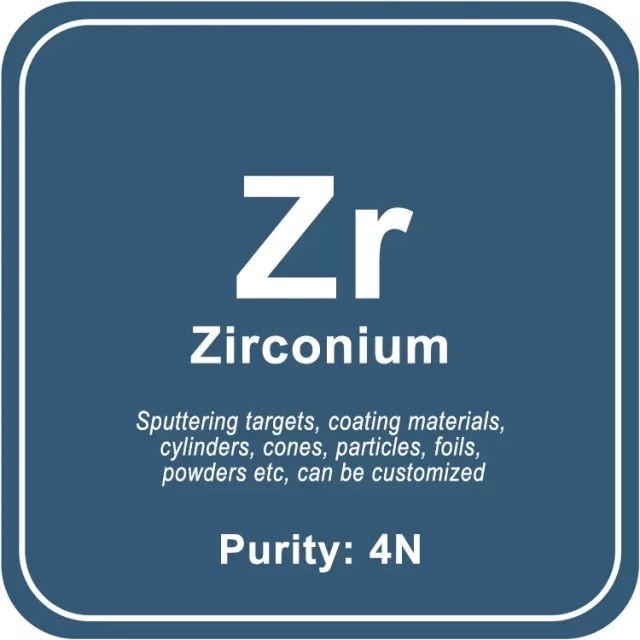
Lab Materials
High Purity Zirconium (Zr) Sputtering Target / Powder / Wire / Block / Granule
Item Number : LM-ZR
Price varies based on specs and customizations
- Chemical Formula
- Zr
- Purity
- 4N
- Shape
- discs / wire / block / powder / plates / column targets / step target / custom-made

Shipping:
Contact us to get shipping details Enjoy On-time Dispatch Guarantee.
We provide laboratory-grade Zirconium (Zr) materials at affordable prices, tailored to your specific needs. Our expertise lies in producing Zirconium (Zr) materials of varying purities, shapes, and sizes.
Our range of products includes sputtering targets (circular, square, tubular, irregular), coating materials, cylinders, cones, particles, foils, powders, 3D printing powders, nanometer powders, wire rods, ingots, blocks, and more, available in different specifications and sizes.
Details










About Zirconium (Zr)
Zirconium is a widely-used material in the field of material science, serving as both a refractory and opacifier. When heated, zirconia undergoes a phase transformation process that yields stabilized zirconia, a valuable refractory material.
In addition to its use as a refractory material, zirconium is also used as an alloying agent due to its strong resistance to corrosion. Zirconium is available in a range of purities, from 99% to 99.999% (ACS grade to ultra-high purity), and is available in various forms including pellets, rod, wire, and granules for evaporation source material purposes.
Zirconium nanoparticles and nanopowders provide an ultra-high surface area, and zirconium oxides are available in various forms, such as powder and dense pellets, for uses in applications such as optical coating and thin film coatings. However, oxides tend to be insoluble, and fluorides are another insoluble form that can be used in metallurgy, chemical and physical vapor deposition, and some optical coatings.
Soluble forms of zirconium, including zirconium chloride, nitrate, and acetate, are also available and can be manufactured as solutions at specified stoichiometries.
Ingredient Quality Control
- Raw material composition analysis
- Through the use of equipment such as ICP and GDMS, the content of metal impurities is detected and analyzed to ensure that it meets the purity standard;
Non-metallic impurities are detected by equipment such as carbon and sulfur analyzers, nitrogen and oxygen analyzers. - Metallographic flaw detection analysis
- The target material is inspected using flaw detection equipment to ensure that there are no defects or shrinkage holes inside the product;
Through metallographic testing, the internal grain structure of the target material is analyzed to ensure that the grains are fine and dense. - Appearance and dimension inspection
- Product dimensions are measured using micrometers and precision calipers to ensure compliance with drawings;
The surface finish and cleanliness of the product are measured using a surface cleanliness meter.
Conventional Sputtering Target Sizes
- Preparation process
- hot isostatic pressing, vacuum melting, etc.
- Sputtering target shape
- plane sputtering target, multi-arc sputtering target, step sputtering target, special-shaped sputtering target
- Round sputtering target size
- Diameter: 25.4mm / 50mm / 50.8mm / 60mm / 76.2mm / 80mm / 100mm / 101.6mm / 152.4mm
Thickness: 3mm / 4mm / 5mm / 6mm / 6.35mm
Size can be customized. - Square sputtering target size
- 50×50×3mm / 100×100×4mm / 300×300×5mm, size can be customized
Available Metal Forms
Metal Forms Details
We manufacture almost all the metals listed on the periodic table in a wide range of forms and purities, as well as standard sizes and dimensions. We can also produce custom-made products to meet specific customer requirements, such as size, shape, surface area, composition, and more. The following list provides a sample of the forms we offer, but it is not exhaustive. If you need laboratory consumables, please contact us directly to request a quote.
- Flat/Planar Forms: Board, Film, Foil, Microfoil, Microleaf, Paper, Plate, Ribbon, Sheet, Strip, Tape, Wafer
- Preformed Shapes: Anodes, Balls, Bands, Bars, Boats, Bolts, Briquettes, Cathodes, Circles, Coils, Crucibles, Crystals, Cubes, Cups, Cylinders, Discs, Electrodes, Fibers, Filaments, Flanges, Grids, Lenses, Mandrels, Nuts, Parts, Prisms, Pucks, Rings, Rods, Shapes, Shields, Sleeves, Springs, Squares, Sputtering Targets, Sticks, Tubes, Washers, Windows, Wires
- Microsizes: Beads, Bits, Capsules, Chips, Coins, Dust, Flakes, Grains, Granules, Micropowder, Needles, Particles, Pebbles, Pellets, Pins, Pills, Powder, Shavings, Shot, Slugs, Spheres, Tablets
- Macrosizes: Billets, Chunks, Cuttings, Fragments, Ingots, Lumps, Nuggets, Pieces, Punchings, Rocks, Scraps, Segments, Turnings
- Porous and Semi-Porous: Fabric, Foam, Gauze, Honeycomb, Mesh, Sponge, Wool
- Nanoscale: Nanoparticles, Nanopowders, Nanofoils, Nanotubes, Nanorods, Nanoprisms
- Others: Concentrate, Ink, Paste, Precipitate, Residue, Samples, Specimens
KinTek specializes in the manufacturing of high-purity and ultra-high-purity materials with a purity range of 99.999% (5N), 99.9999% (6N), 99.99995% (6N5), and in some cases, up to 99.99999% (7N). Our materials are available in specific grades, including UP/UHP, semiconductor, electronic, deposition, fiber optic, and MBE grades. Our high-purity metals, oxides, and compounds are specifically crafted to meet the rigorous demands of high-technology applications and are ideal for use as dopants and precursor materials for thin film deposition, crystal growth of semiconductors, and synthesis of nanomaterials. These materials find use in advanced microelectronics, solar cells, fuel cells, optical materials, and other cutting-edge applications.
Packaging
We use vacuum packaging for our high-purity materials, and each material has specific packaging tailored to its unique characteristics. For instance, our Hf sputter target is externally tagged and labeled to facilitate efficient identification and quality control. We take great care to prevent any damage that could occur during storage or transportation.
FAQ
What Is Sputtering Target?
How Are Sputtering Targets Made?
What Is Sputtering Target Used For?
What Are Sputtering Targets For Electronics?
What Is The Lifetime Of A Sputtering Target?
4.9
out of
5
KINTEK's Zirconium materials are top-notch in quality. Our research team highly appreciates the purity and consistency of their products.
4.7
out of
5
As a lab manager, I prioritize value for money. KINTEK's Zirconium products offer excellent performance at a competitive price.
4.8
out of
5
KINTEK's Zirconium materials have been instrumental in our lab's groundbreaking research. Their high purity enables us to achieve accurate and reliable results.
4.6
out of
5
The durability of KINTEK's Zirconium products is remarkable. We've been using them for years, and they continue to perform exceptionally.
4.9
out of
5
KINTEK's commitment to technological advancement is evident in their Zirconium materials. They are always pushing the boundaries of innovation.
4.7
out of
5
Exceptional speed of delivery from KINTEK. We received our order of Zirconium materials within days, allowing us to proceed with our experiments promptly.
4.8
out of
5
KINTEK's Zirconium materials have enabled us to produce high-quality coatings with precise control over thickness and uniformity.
4.6
out of
5
The purity of KINTEK's Zirconium materials is unmatched. Our research team has achieved remarkable results using their products.
4.9
out of
5
KINTEK's Zirconium materials are a game-changer for our lab. They have improved the accuracy and repeatability of our experiments significantly.
4.7
out of
5
KINTEK's Zirconium products are a cost-effective solution for our research needs. Their competitive pricing allows us to maximize our budget.
4.8
out of
5
The quality of KINTEK's Zirconium materials is impeccable. Our team has been consistently impressed with their performance.
4.6
out of
5
KINTEK's Zirconium materials have enabled us to explore new and exciting research avenues. Their products have been a valuable asset to our lab.
4.9
out of
5
KINTEK's Zirconium materials are a testament to their commitment to excellence. We highly recommend their products to researchers seeking the highest quality.
4.7
out of
5
KINTEK's Zirconium materials have exceeded our expectations. Their exceptional purity and consistency have been instrumental in our successful experiments.
4.8
out of
5
KINTEK's Zirconium materials have revolutionized our research. Their advanced properties have enabled us to achieve groundbreaking results.
4.6
out of
5
KINTEK's Zirconium materials are the gold standard in our lab. Their reliability and performance have been unmatched.
4.9
out of
5
KINTEK's Zirconium materials are a true game-changer. They have transformed our research capabilities and enabled us to push the boundaries of science.
REQUEST A QUOTE
Our professional team will reply to you within one business day. Please feel free to contact us!
Related Products
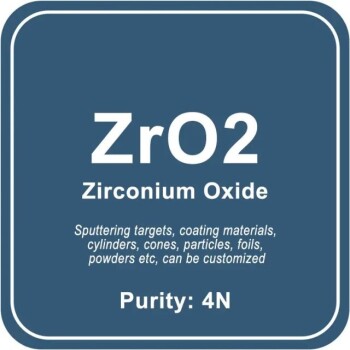
High Purity Zirconium Oxide (ZrO2) Sputtering Target / Powder / Wire / Block / Granule
Get high-quality Zirconium Oxide (ZrO2) materials tailored to your needs. We offer a variety of shapes and sizes, including sputtering targets, powders, and more, at affordable prices.
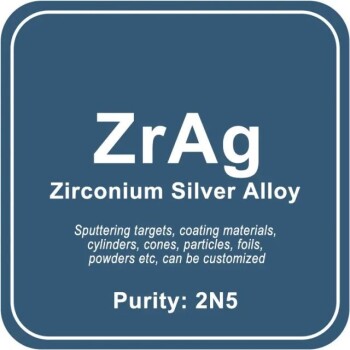
Zirconium Silver Alloy (ZrAg) Sputtering Target / Powder / Wire / Block / Granule
Discover affordable Zirconium Silver Alloy (ZrAg) materials for laboratory use. Our tailored solutions cater to your unique needs with varying purities, shapes, and sizes. Find sputtering targets, coatings, particles, powders, and more.
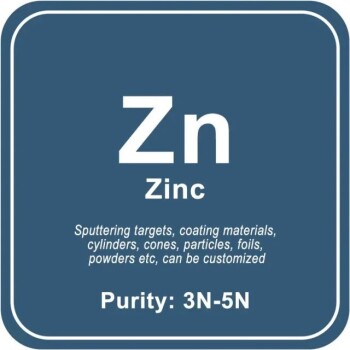
High Purity Zinc (Zn) Sputtering Target / Powder / Wire / Block / Granule
Find high-quality Zinc (Zn) materials for laboratory use at affordable prices. Our experts produce and customize materials of different purities, shapes, and sizes to suit your needs. Browse our range of sputtering targets, coating materials, and more.
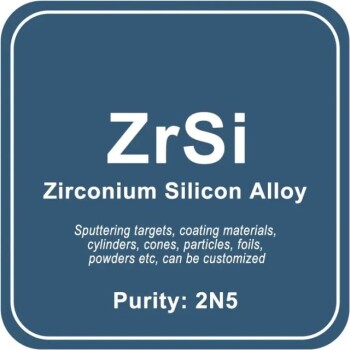
Zirconium Silicon Alloy (ZrSi) Sputtering Target / Powder / Wire / Block / Granule
Discover our Zirconium Silicon Alloy (ZrSi) materials for laboratory use at affordable prices. We produce tailored materials to fit your unique requirements, offering a wide range of specifications and sizes for sputtering targets, coating materials, powders, and more.

Copper Zirconium Alloy (CuZr) Sputtering Target / Powder / Wire / Block / Granule
Discover our range of Copper Zirconium Alloy materials at affordable prices, tailored to your unique requirements. Browse our selection of sputtering targets, coatings, powders, and more.
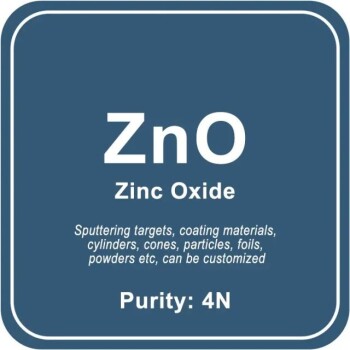
High Purity Zinc Oxide (ZnO) Sputtering Target / Powder / Wire / Block / Granule
Find top-quality Zinc Oxide (ZnO) materials for your laboratory needs at great prices. Our expert team produces tailored materials in various purities, shapes, and sizes, including sputtering targets, coating materials, powders, and more. Shop now!

Zinc Sulfide (ZnS) Sputtering Target / Powder / Wire / Block / Granule
Get affordable Zinc Sulfide (ZnS) materials for your laboratory needs. We produce and customize ZnS materials of varying purities, shapes, and sizes. Choose from a wide range of sputtering targets, coating materials, powders, and more.
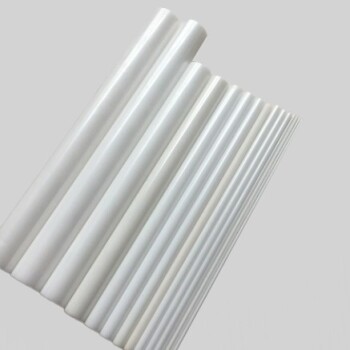
Zirconia Ceramic Rod - Stabilized Yttrium Precision Machining
Zirconia ceramic rods are prepared by isostatic pressing, and a uniform, dense and smooth ceramic layer and transition layer are formed at high temperature and high speed.
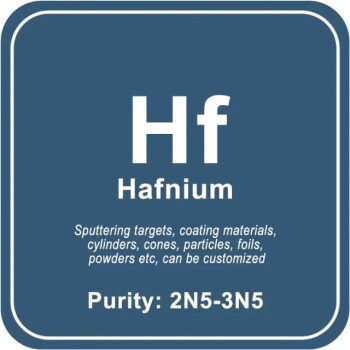
High Purity Hafnium (Hf) Sputtering Target / Powder / Wire / Block / Granule
Get high-quality Hafnium (Hf) materials tailored to your lab needs at reasonable prices. Find various shapes and sizes for sputtering targets, coating materials, powders, and more. Order now.

Zirconia Ceramic Plate - Yttria Stabilized Precision Machined
Yttrium-stabilized zirconia has the characteristics of high hardness and high temperature resistance, and has become an important material in the field of refractories and special ceramics.

Zirconia Ceramic Gasket - Insulating
Zirconia insulating ceramic gasket has high melting point, high resistivity, low thermal expansion coefficient and other properties, making it an important high temperature resistant material, ceramic insulating material and ceramic sunscreen material.
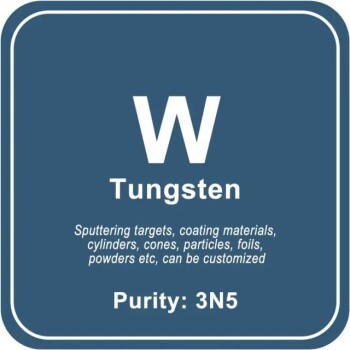
High Purity Tungsten (W) Sputtering Target / Powder / Wire / Block / Granule
Find high-quality Tungsten (W) materials for your laboratory needs at affordable prices. We offer customized purities, shapes, and sizes of sputtering targets, coating materials, powders, and more.
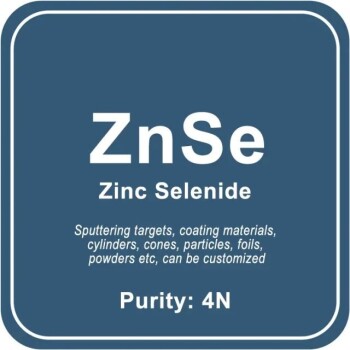
Zinc Selenide (ZnSe) Sputtering Target / Powder / Wire / Block / Granule
Looking for Zinc Selenide (ZnSe) materials for your laboratory? Our affordable prices and expertly tailored options make us the perfect choice. Explore our wide range of specifications and sizes today!

Zirconia Ceramic Ball - Precision Machining
zirconia ceramic ball have the characteristics of high strength, high hardness, PPM wear level, high fracture toughness, good wear resistance, and high specific gravity.
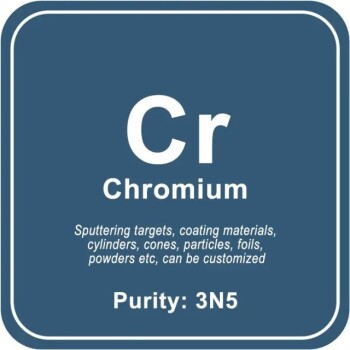
High Purity Chromium (Cr) Sputtering Target / Powder / Wire / Block / Granule
Get affordable Chromium materials for your laboratory needs. We produce custom shapes and sizes, including sputtering targets, foils, powders, and more. Contact us today.

Alumina Zirconia Special-Shaped Parts Processing Custom-Made Ceramic Plates
Alumina ceramics have good electrical conductivity, mechanical strength and high temperature resistance, while zirconia ceramics are known for their high strength and high toughness and are widely used.
Related Articles

Top 5 Features of a High-Quality Zirconia Sintering Oven
Investing in a high-quality sintering oven is crucial for dental laboratories that want to produce high-quality zirconia restorations consistently.

Cold Isostatic Pressing: An Overview and its Industrial Applications
Cold isostatic pressing (CIP) is a method of processing materials by using liquid pressure to compact powder. It is similar to metal mold processing and is based on Pascal's law.

Comprehensive Overview of Zirconia Ceramic Materials
A detailed exploration of zirconia ceramics, including properties, history, preparation, molding, sintering, and applications.

Precautions for Preparing Lead Zirconate Titanate (PZT) Film Layers by Magnetron Sputtering
Guidelines and precautions for preparing PZT film layers using magnetron sputtering.

Research on Zirconia Ceramics in Dental Restoration
Explores the properties, preparation, and advantages of zirconia ceramics in dental restoration.

PVD Sputtering Targets and Hot Isostatic Pressing: Part 2
This article discusses the manufacturing and optimization of PVD sputtering targets, focusing on techniques like hot isostatic pressing and high pressure heat treatment.

Understanding and Preventing Magnetron Sputtering Target Poisoning
Discusses the phenomenon of target poisoning in magnetron sputtering, its causes, effects, and preventive measures.